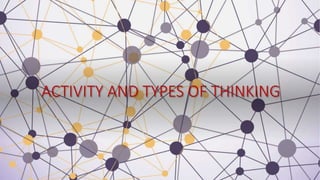
Activity and thinking.pptx
- 1. ACTIVITY AND TYPES OF THINKING
- 2. MATCHING TYPES OF THINKING Identifying, labelling, naming, describing, measuring, estimating, describing cause and effect/ problems and solutions. KEY VISUAL Flashcards, cards for snap, Bingo, Dominoes, maps, labelled diagrams, diagrams with captions, tables, materials
- 3. SORTING TYPES OF THINKING Classifying, defining, generalizing, comparing, contrasting KEY VISUALS Tree diagrams, tables, tick charts, diagrams
- 4. SEQUENCING TYPES OF THINKING Sequencing, describing process and cycles, narrating events or chronological order KEY VISUALS Timelines, flow charts, cycle diagrams, picture sequence
- 5. RANKING • TYPES OF THINKING • Evaluating, judging size, importance etc, applying criteria, selecting, comparing • KEY VISULAS Rating tables, continua, bull’s eye charts
- 6. Activity • Sequencing letters, parts of body, whole words or sentences and sequencing them to make words, phrases or sentences. The pupils read and sequence items Purpose Learning to read: building up letter and word recognition, morphemic and syntactic awareness Reading to learn: checking understanding at sentence level Reading to physically settle or calm pupils Reading to encourage mental activity and problem-solving Materials: Flashcards or worksheets with letters, prefixes, words Moveable cards are good for a kinesthetic learning style.
- 7. Matching or mapping pictures and words or two halves of a sentence so that they make sense. The pupils read and match the parts so that they make sense. The extracts can be on a tape also to reinforce listening skills Learning to read: developing syntactic awareness Reading to learn: understanding how markers like but, or first then next organize discourse Reading to encourage mental activity and problem-solving Materials: Flashcards with cards and/or pictures Graphic organizer such as a tickchart or flow chart to say
- 8. Understanding text types. The pupils learn words for different kinds of text, eg, manual, TV guide, menu, brochure and match text type to their label and purpose, eg this is a kind of sign it gives us a warning. Purpose: Reading to learn: to develop awareness of text types, their layout, purpose, etc Reading to encourage mental activity and problem solving. Materials: Different example of text-type+ sets of cards, one with the text type name on, the other with the purpose which pupils match